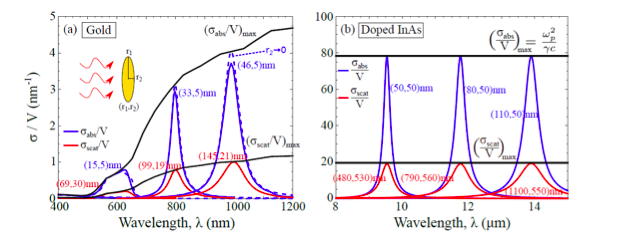Researchers from Skoltech, MIT and Yale derive new formulas that identify the fundamental limits to the optical response in absorptive systems.
At visible and infrared frequencies, metals show tantalizing promise for strong subwavelength resonances, but material loss typically dampens the response. A research team from Skoltech, MIT, and Yale derived fundamental limits to the optical response of absorptive systems, bounding the largest enhancements possible given intrinsic material losses (Figure 1). Through basic conservation-of-energy principles, the authors derive geometry-independent limits to per-volume absorption and scattering rates, and to local-density-of-states enhancements that represent the power radiated or expended by a dipole near a material body.
Skoltech professor Athanasios Polimeridis and his colleagues Owen Miller and Homer Reid, postdocs at MIT, Chia Wei Hsu, postdoc at Yale, Brendan Delacy, researcher at Edgewood Chemical Biological Center, John Joannopoulos and Marin Soljacic, professors of Physics at MIT, and Steven Johnson, professor of Mathematics at MIT, have published their results in Optics Express.
Professor Polimeridis works with fundamental optical systems for a long time. The key distinction between this work and previously published papers is that in this paper the authors find limits in the full Maxwell regime, such that the derived bounds apply to any structure at any size scale, and they apply to functions of the scattered fields (e.g. scattered power and radiative LDOS), which have zero amplitude in quasistatic electromagnetism. An additional benefit of the current simplified energy-conservation approach is that we can bound the responses of anisotropic, magnetic, and/or inhomogeneous media. Finally, in this work the authors also consider the local density of states, which represents an important design application.
- D. Miller, A. G. Polimeridis, M. T. H. Reid, C. W. Hsu, B. G. Delacy, J. D. Joannopoulos, M. Soljacic, and S. G. Johnson.
Fundamental limits to optical response in absorptive systems.
Optics Express, 24 (4): 3329-3364, 2016.
Link: https://www.osapublishing.org/oe/abstract.cfm?uri=oe-24-4-3329

Figure 1. Absorption (blue) and scattering (red) cross-sections per unit particle volume for nanoparticles of (a) gold and (b) Si-doped InAs, illuminated by plane waves polarized along the particle rotation axis. The ellipsoid aspect ratios can be tuned to approach both the maximum absorption and maximum scattering cross-sections (black). The dimensions of the nanoparticles are optimized at three representative wavelengths, in the visible for gold (constrained to have radii not less than 5 nm) and at longer infrared wavelengths for doped InAs. Whereas the maximum-absorption particles are small to exhibit quasistatic behavior, represented by dashed lines in (a), the maximum-scattering particles are larger such that their scattering and absorption rates are equal.
The Skolkovo Institute of Science and Technology (Skoltech) is a private graduate research university in Skolkovo, Russia, a suburb of Moscow. Established in 2011 in collaboration with MIT, Skoltech educates global leaders in innovation, advances scientific knowledge, and fosters new technologies to address critical issues facing Russia and the world. Applying international research and educational models, the university integrates the best Russian scientific traditions with twenty-first century entrepreneurship and innovation.
